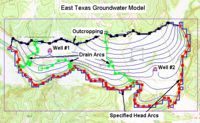GMS:Map Module: Difference between revisions
From XMS Wiki
Jump to navigationJump to search
No edit summary |
No edit summary |
||
| (9 intermediate revisions by the same user not shown) | |||
| Line 2: | Line 2: | ||
The Map module provides a suite of tools for using [[GMS:Feature Objects|feature objects]] to build [[GMS:Feature Objects#Conceptual Models|conceptual models]]. | The Map module provides a suite of tools for using [[GMS:Feature Objects|feature objects]] to build [[GMS:Feature Objects#Conceptual Models|conceptual models]]. | ||
Feature objects are used to provide some GIS-like capabilities within GMS. Feature objects include points, arcs, and polygons. Feature objects can be grouped into layers or [[GMS:Coverages|coverages]]. A set of coverages can be constructed representing a conceptual model of a groundwater modeling problem. This high level representation can be used to automatically generate numerical models such as MODFLOW and MT3DMS. Feature objects can also be used for automated mesh generation. | Feature objects are used to provide some GIS-like capabilities within GMS. Feature objects include points, arcs, and polygons. Feature objects can be grouped into layers or [[GMS:Coverages|coverages]]. Multiple coverages and conceptual models can exist in a single GMS project. A set of coverages can be constructed representing a conceptual model of a groundwater modeling problem. This high level representation can be used to automatically generate numerical models such as MODFLOW and MT3DMS. Feature objects can also be used for automated mesh generation. | ||
The Map module is often used as a starting point for many project. Often, a project starts with an image then, on a coverage, the | The Map module is often used as a starting point for many project. Often, a project starts with an [[GMS:Images|image]] then, on a coverage, the [[GMS:Feature Object Tool Palette|module tools]] are used to create feature objects over the image to represent boundaries and structures. Then the feature objects are [[GMS:Map to Modules|converted]] to other data types for further processing. | ||
[[Image:easttex.jpg|thumb|none|left|500px]] | For the purpose of converting feature objects to 2D or 3D grids, the module contains a [[GMS:Grid Frame|grid frame]] tool to define the boundaries and properties of the grid being created. | ||
The Map module also contains its own [[GMS:Feature Object Commands|menu commands]] and its own [[GMS:Feature Object Display Options|display options]]. | |||
[[Image:easttex.jpg|thumb|none|left|500px|Example of feature objects drawn on a coverage over an image]] | |||
The Map module, including the conceptual modeling tools, is included with all [http://www.aquaveo.com/software/gms-pricing paid editions] of GMS. | The Map module, including the conceptual modeling tools, is included with all [http://www.aquaveo.com/software/gms-pricing paid editions] of GMS. | ||
| Line 13: | Line 17: | ||
{{Navbox GMS}} | {{Navbox GMS}} | ||
[[Category:Feature Objects]] | [[Category:Feature Objects]] | ||
[[Category:Map Module]] | |||

